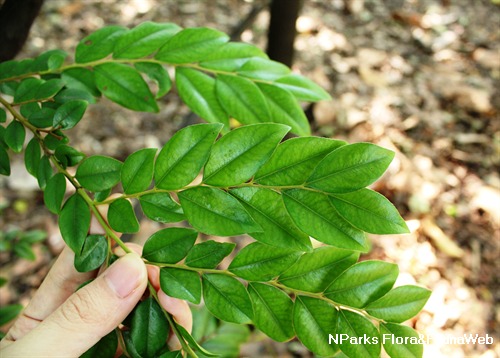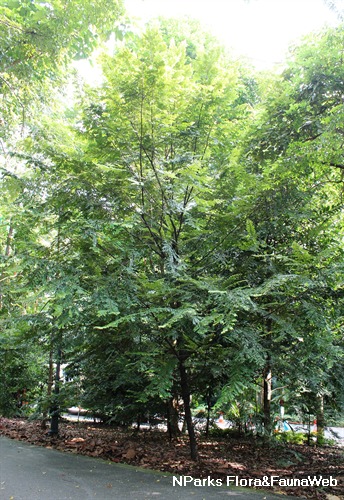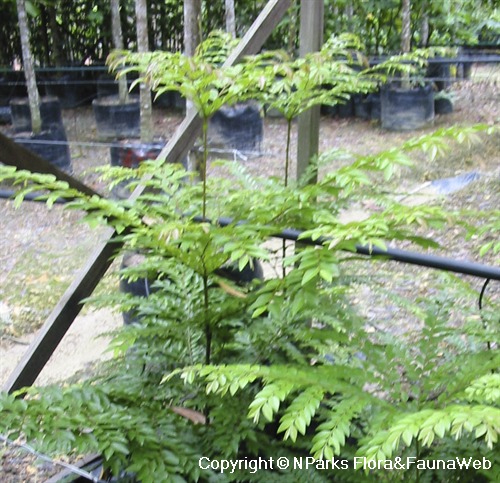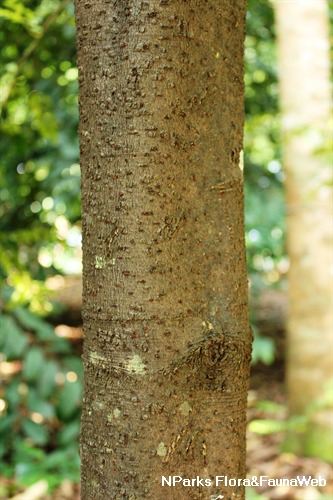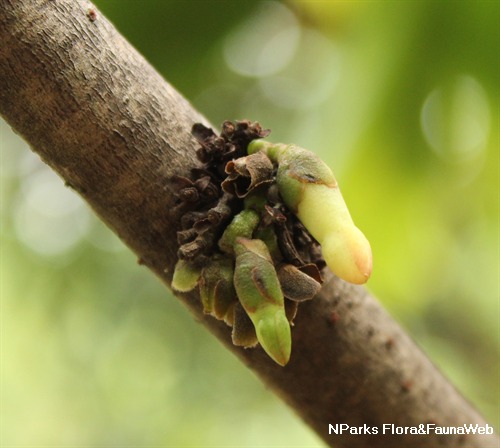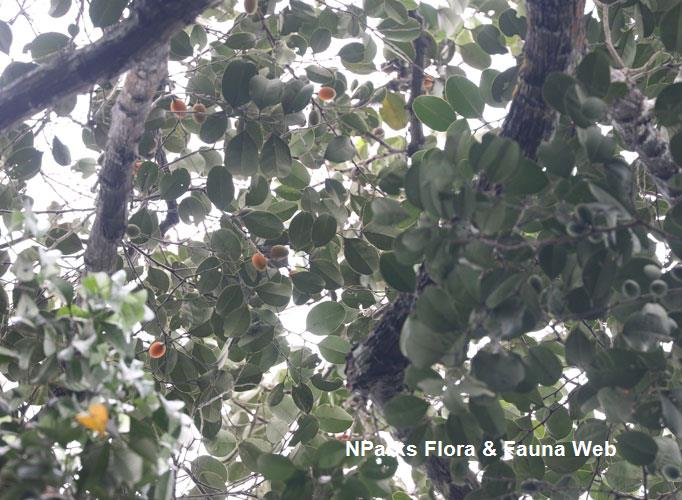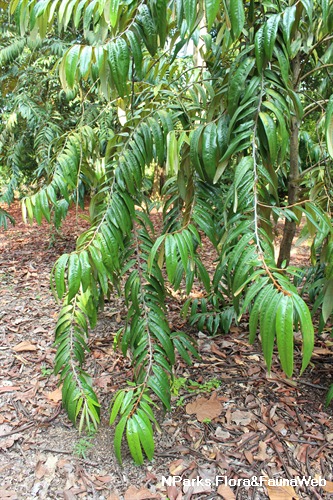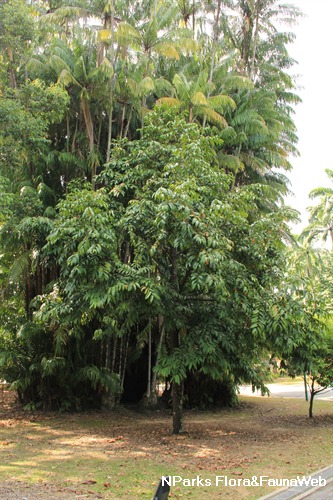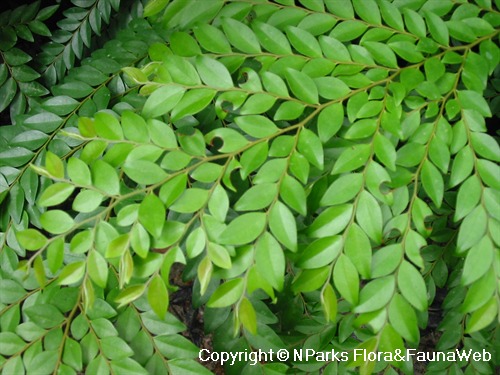
Name
Classifications and Characteristics
| Plant Division | Angiosperms (Flowering Seed Plants) (Dicotyledon) |
|---|---|
| Plant Growth Form | Tree (Big (>30m)) |
| Lifespan (in Singapore) | Perennial |
| Mode of Nutrition | Autotrophic |
| Plant Shape | Irregular |
| Maximum Height | 35 m |
Biogeography
| Native Distribution | India, Sri Lanka, Myanmar, Vietnam, Laos, Thailand, Cambodia, Peninsular Malaysia, Singapore, to the rest of Southeast Asia, and New Guinea. |
|---|---|
| Native Habitat | Terrestrial (Primary Rainforest, Mountain, Secondary Rainforest) |
| Preferred Climate Zone | Tropical, Sub-Tropical / Monsoonal |
| Local Conservation Status | Native to Singapore (Critically Endangered (CR)) |
Description and Ethnobotany
| Growth Form | It is a tree, up to 35 m tall. |
|---|---|
| Foliage | Its alternate, stalked leaves have leaf blades that are elliptic or almost rhomboid, and 1.2-7 cm long and 0.5-3 cm wide, with faint, lateral veins. |
| Flowers | Its tiny male flowers grow in clusters of 2-5, and its tiny female flowers develop singly. |
| Fruit | Its ellipsoid fruits are 1.6 cm long. |
| Habitat | It grows in lowland, hill and lower montane forests, up to 1,000 m altitude. |
| Associated Fauna | It is the food plant for caterpillars of the butterflies, the chocolate albatross (Appias lyncida vasava) and the Quaker (Neopithecops zalmora zalmora). |
| Cultivation | It can be propagated by seed. |
| Etymology | Greek dios, divine; Greek pyros, wheat, meaning divine wheat or food; Latin, buxifolia, box-leafed, referring to the almost rhomboid shaped leaves. |
| Ethnobotanical Uses | Timber & Products: It produces black heart-wood which is said to supply the best Malacca ebony. The timber was used for building. |
Landscaping Features
| Landscaping | It is suitable for gardens, parks and roadsides. |
|---|---|
| Desirable Plant Features | Ornamental Foliage |
| Landscape Uses | General, Suitable for Roadsides, Parks & Gardens, Small Gardens |
Fauna, Pollination and Dispersal
| Fauna Pollination Dispersal Associated Fauna | Butterfly Host Plant (Associated with: Appias lyncida, Neopithecops zalmora) |
|---|---|
| Pollination Method(s) | Biotic (Fauna) |
| Seed or Spore Dispersal | Biotic (Fauna) |
Plant Care and Propagation
| Light Preference | Semi-Shade, Full Sun |
|---|---|
| Water Preference | Lots of Water, Moderate Water |
| Plant Growth Rate | Moderate |
| Rootzone Tolerance | Moist Soils, Well-Drained Soils, Fertile Loamy Soils |
| Propagation Method | Seed |
Foliar
| Foliage Retention | Evergreen |
|---|---|
| Mature Foliage Colour(s) | Green |
| Mature Foliage Texture(s) | Leathery |
| Prominent Young Flush Colour(s) | Pink |
| Young Flush Texture(s) | Leathery |
| Foliar Type | Simple / Unifoliate |
| Foliar Arrangement Along Stem | Alternate |
| Foliar Attachment to Stem | Petiolate |
| Foliar Shape(s) | Non-Palm Foliage (Elliptical) |
| Foliar Venation | Pinnate / Net |
| Foliar Margin | Entire |
| Foliar Apex - Tip | Acute |
| Foliar Base | Cuneate |
| Leaf Area Index (LAI) for Green Plot Ratio | 4.0 (Tree - Dense Canopy) |
Floral (Angiosperm)
| Flower & Plant Sexuality | Unisexual Flowers , Dioecious |
| Flower Grouping | Solitary, Cluster / Inflorescence |
|---|
| Flower Location | Axillary |
Fruit, Seed and Spore
| Fruit Classification | Simple Fruit |
|---|---|
| Fruit Type | Fleshy Fruit , Non-Accessory Fruit |
Image Repository
Others
| Master ID | 1557 |
|---|---|
| Species ID | 2850 |
| Flora Disclaimer | The information in this website has been compiled from reliable sources, such as reference works on medicinal plants. It is not a substitute for medical advice or treatment and NParks does not purport to provide any medical advice. Readers should always consult his/her physician before using or consuming a plant for medicinal purposes. |

